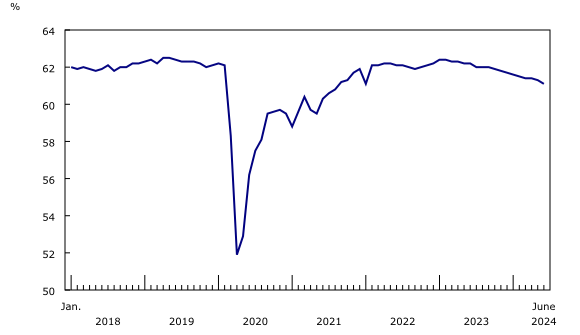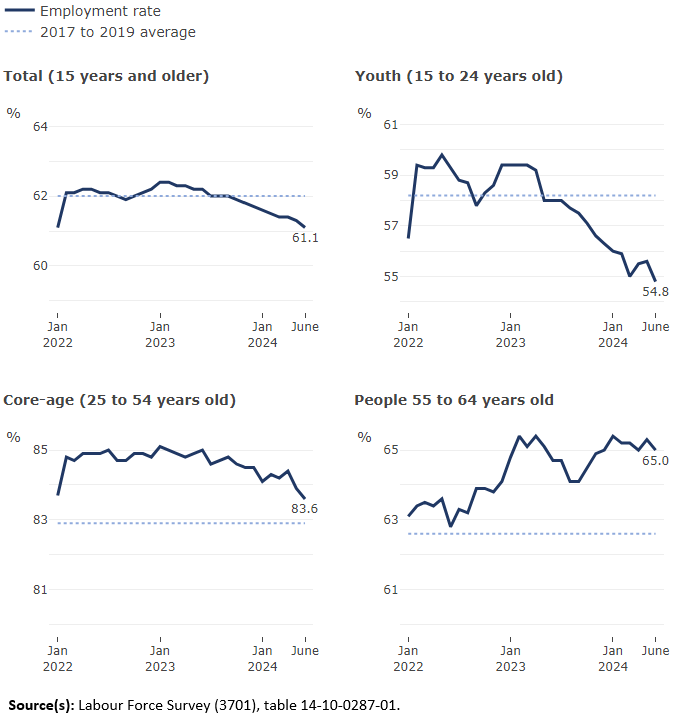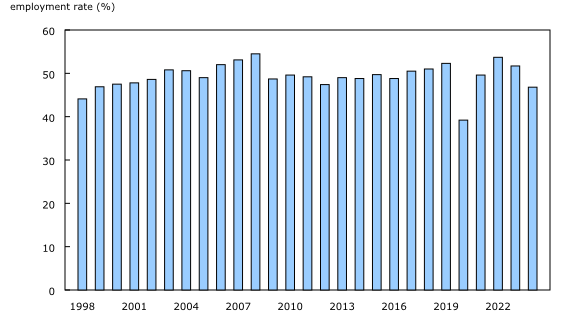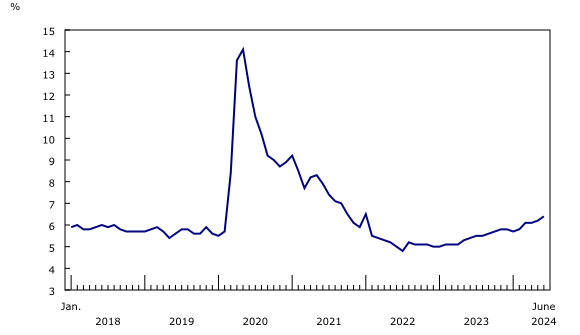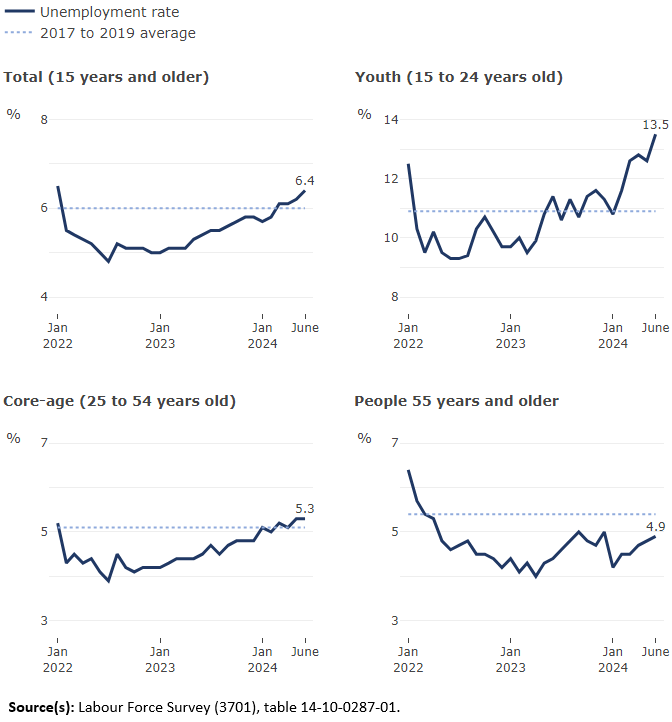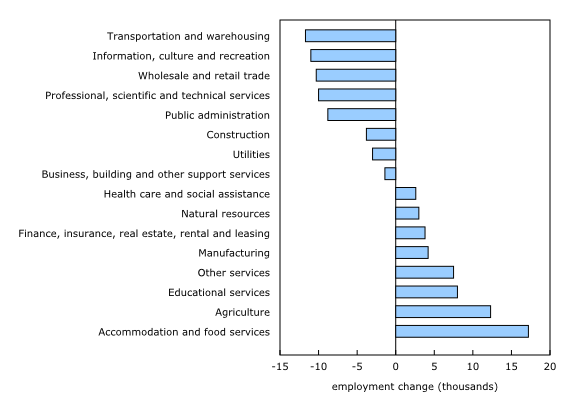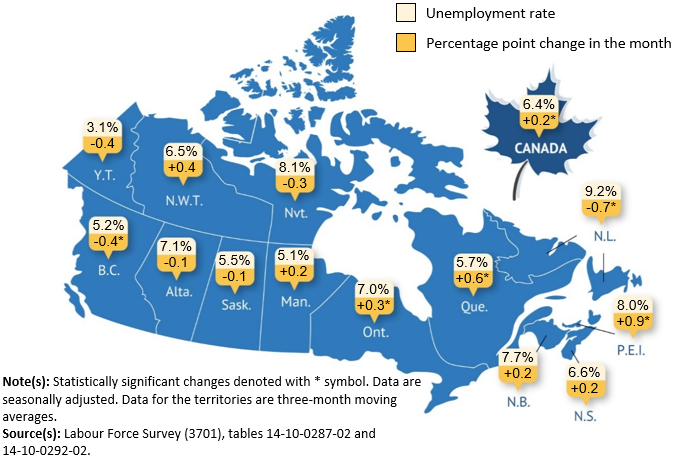Labour Force Survey, June 2024
Released: 2024-07-05
Highlights
Employment was virtually unchanged in June (-1,400; -0.0%), and the employment rate fell 0.2 percentage points to 61.1%.
The unemployment rate increased 0.2 percentage points to 6.4% in June and has risen 1.3 percentage points since April 2023.
In June, employment fell among young men aged 15 to 24 (-13,000; -0.9%), while it increased for core-aged women (aged 25 to 54) (+19,000; +0.3%).
There were declines in the number of people working in transportation and warehousing (-12,000; -1.1%) as well as in public administration (-8,800; -0.7%) in June. At the same time, there were more people employed in accommodation and food services (+17,000; +1.5%) and in agriculture (+12,000; +5.5%).
Employment declined in Quebec (-18,000; -0.4%) in June, while it increased in New Brunswick (+3,000; +0.8%) and Newfoundland and Labrador (+2,600; +1.1%).
Total hours worked were down 0.4% in June. On a year-over-year basis, total hours worked were up 1.1%.
Average hourly wages among employees increased 5.4% in June on a year-over-year basis, following growth of 5.1% in May (not seasonally adjusted).
The employment rate for returning students aged 15 to 24 was 46.8% in June, down from 51.7% a year earlier (not seasonally adjusted).
Employment virtually unchanged in June
Employment was virtually unchanged (-1,400; -0.0%) in June, following little change in May (+27,000; +0.1%).
The employment rate—the proportion of the population aged 15 and older who are employed—declined by 0.2 percentage points to 61.1% in June, the eighth decrease in the past nine months. The employment rate has declined by 1.3 percentage points from the recent high of 62.4% observed in January and February of 2023.
On a year-over-year basis, employment was up by 1.7% (+343,000) in June 2024. Employment growth in the 12 months to June was faster in the public sector (+4.3%; +183,000) than in the private sector (+0.8%; +106,000). Self-employment in June was up on a year-over-year basis (+2.1%; +55,000), but remained lower than its average from 2017 to 2019 (-4.3%; -121,000), prior to the COVID-19 pandemic.
Employment rate declines for youth and core-aged men
Employment fell among young men aged 15 to 24 in June (-13,000; -0.9%), while it held steady for young women. The overall youth employment rate has been on a strong downward trend since April 2023, falling 4.4 percentage points to 54.8% in June 2024.
For men aged 25 to 54, employment was little changed (-14,000; -0.2%) in June, and the employment rate fell 0.5 percentage points to 86.6%. This extended a downward trend in the employment rate from a recent high of 88.2% in June 2023. The rate in June 2024 was comparable to the pre-pandemic average of 86.5% observed from 2017 to 2019.
For women aged 25 to 54, employment rose in June 2024 (+19,000; +0.3%) and the employment rate held steady at 80.6%. The employment rate of core-aged women has trended down from the record high of 82.0% in January and March of 2023, but remained above the pre-pandemic average observed from 2017 to 2019 (79.3%).
Employment for people aged 55 to 64 was little changed in June 2024. On a year-over-year basis, the employment rate for people in this age group was up by 0.9 percentage points to 69.8% for men, and was little changed at 60.4% for women.
Employment rate of returning students at its lowest point since June 1998
From May to August, the Labour Force Survey collects labour market information from students who attended school full time in March and who intend to return to school full time in the fall.
In June, the employment rate for returning students aged 15 to 24 was 46.8%, the lowest rate since June 1998, outside of June 2020 during the first year of the pandemic (not seasonally adjusted). This marks a notable decline from the recent high of 53.7% observed in June 2022.
The unemployment rate among returning students was 15.9% in June 2024, and was up 3.8 percentage points from a year earlier. This indicates that students are facing more difficulties finding work as they enter the summer job market.
In June, the employment rate for male returning students was 44.4%, down 5.5 percentage points from a year earlier. Among female returning students, 49.0% were employed in June, down 4.4 percentage points over the same period.
Returning students who were employed in June 2024 were more likely to work part-time (68.0%) compared with June 2023 (66.9%) and June 2022 (63.9%).
Unemployment rate rises to 6.4%
The overall unemployment rate rose 0.2 percentage points to 6.4% in June. It has trended up since April 2023, rising 1.3 percentage points over the period. There were 1.4 million unemployed people in June 2024, an increase of 42,000 (+3.1%) from the previous month.
Of those who were unemployed in May, just over one-fifth (21.4%) had transitioned to employment in June (not seasonally adjusted). This was lower than the pre-pandemic average for the same months in 2017, 2018, and 2019 (26.7%). A lower proportion of unemployed people transitioning into employment may indicate that people are facing greater difficulties finding work in the current labour market.
As the unemployment rate has increased over the past year, so too has the proportion of long-term unemployed. Among the unemployed, 17.6% had been continuously unemployed for 27 weeks or more in June 2024, up 4.0 percentage points from a year earlier.
Older unemployed persons were more likely to be in long-term unemployment; 22.0% of unemployed people aged 55 and older had been continuously unemployed for 27 weeks or more in June. In comparison, the proportion was 19.3% for those in the core-aged group and 12.2% for youth.
Youth unemployment rate increases in June
The overall unemployment rate for youth (aged 15 to 24) rose 0.9 percentage points to 13.5% in June. This was the highest rate since September 2014, outside of 2020 and 2021 during the pandemic. On a year-over-year basis, the youth unemployment rate was up 2.1 percentage points in June 2024.
The unemployment rate for core-aged men rose 0.2 percentage points to 5.6% in June. The rate for this group has trended up from a recent low of 4.0% in October 2022. Among core-aged women, the unemployment rate was unchanged at 5.1% in June 2024, and was up from a recent low of 4.1% in January 2023.
For people aged 55 and older, the unemployment rate was little changed at 4.9% in June 2024. On a year-over-year basis, it was up by 0.7 percentage points to 5.1% for men in this age group, while it was little changed at 4.8% for women.
Unemployment rates rise for Black and South Asian Canadians
In the 12 months to June, the unemployment rate rose by 4.4 percentage points to 11.9% for core-aged Black Canadians (three-month moving averages, not seasonally adjusted). The rate was up by 5.7 percentage points to 12.3% for Black men and by 3.0 percentage points to 11.4% for Black women.
Among South Asians in the core-aged group, the unemployment rate was up 1.7 percentage points on a year-over-year basis to 6.7% in June. For core-aged South Asian women, the unemployment rate was 7.8% (+1.8 percentage points from a year earlier), while it was 5.9% for core-aged South Asian men (+1.7 percentage points from a year earlier).
For core-aged Chinese Canadians, the unemployment rate was 6.3% in June, and was little changed compared with 12 months earlier.
In comparison, the unemployment rate rose by 0.3 percentage points to 3.8% in the 12 months to June among the non-racialized, non-Indigenous population of core working age.
Wages increase on a year-over-year basis in June
On a year-over-year basis, average hourly wages for employees were up by 5.4% (+$1.79 to $34.91) in June, following growth of 5.1% in May. Average hourly wages were up by 5.2% (+$1.62 to $32.57) among women in June and by 5.5% (+$1.92 to $37.13) among men.
Wage growth remained relatively widespread across the wage distribution. On a year-over-year basis, the average hourly wage for employees in the bottom 25% of the wage distribution was up by 4.2% (to $17.74 per hour) in June, while for those in the top 25% of the wage distribution, it was up by 6.9% to $61.27 per hour.
In general, year-over-year growth in average hourly wages can reflect a range of factors, including changes in wages, composition of employment, and base-year effects.
Employment falls in transportation and warehousing for the second consecutive month
Employment in transportation and warehousing fell by 12,000 (-1.1%) in June, following a decline of 21,000 (-1.9%) in May. Employment in this industry was little changed on a year-over-year basis.
In public administration, employment declined by 8,800 (-0.7%) in June, the first decline since August 2023. On a year-over-year basis, employment in public administration was up by 24,000 (+2.0%).
Employment increased by 17,000 (+1.5%) in accommodation and food services in June, marking the third consecutive monthly increase, and bringing cumulative increases to 54,000 (+4.9%) since March.
In agriculture, employment rose by 12,000 (+5.5%) in June, the first increase since July 2023. Despite this increase, employment in agriculture was down by 18,000 (-7.2%) on a year-over-year basis in June 2024.
Employment declines in Quebec, while New Brunswick and Newfoundland and Labrador post increases
Employment in Quebec declined by 18,000 (-0.4%) in June, following little change in May. In the 12 months to June, employment in Quebec was little changed, and the employment rate fell 1.2 percentage points to 60.8%. In June, the unemployment rate in the province increased 0.6 percentage points to 5.7%.
In New Brunswick, employment rose by 3,000 (+0.8%) in June, the second increase in three months. The participation rate increased 0.3 percentage points in the month to 61.4%, leaving the unemployment rate little changed at 7.7%. Compared with 12 months earlier, employment in the province was up 4.2% (+16,000).
Employment also increased in Newfoundland and Labrador (+2,600; +1.1%) in June, lowering the unemployment rate to 9.2% (-0.7 percentage points). The employment increase in the month offset the decline in May and was the first monthly gain since January 2024.
While Ontario posted little change in employment in June, the unemployment rate increased 0.3 percentage points to 7.0%, as more Ontarians were searching for work. The unemployment rate in Ontario has increased 1.9 percentage points from its recent low of 5.1% in April 2023.
In the Spotlight: Teleworkers with a remote work location make up a growing share of employees usually working at home
The pandemic led to a notable shift towards working from home and hybrid work arrangements. Though the proportion of Canadians working from home has trended downwards following the lifting of most pandemic-related public health restrictions in 2022, some of the labour market trends associated with telework remain.
Among employees who usually work most of their hours from home, some report to a work location in the same city or nearby, while others report to a more remote work location, which may be situated beyond a commutable distance.
In June 2024, the proportion of employees who usually worked most of their hours from home was 15.1%, down from 21.5% in June 2022. This decrease was driven by a decline in the proportion of employees who usually worked mostly from home and whose office or work site was in the same city or nearby, down 6.4 percentage points to 11.4% from June 2022 to June 2024.
Thus, teleworkers with a more remote work location made up a growing share of employees who usually worked mostly from home, with just under one-quarter (24.2%) doing so in June 2024, up from 17.2% in June 2022.
Did you know we have a mobile app?
Download our mobile app and get timely access to data at your fingertips! The StatsCAN app is available for free on the App Store and on Google Play.
Sustainable Development Goals
On January 1, 2016, the world officially began implementation of the 2030 Agenda for Sustainable Development—the United Nations' transformative plan of action that addresses urgent global challenges over the next 15 years. The plan is based on 17 specific sustainable development goals.
The Labour Force Survey is an example of how Statistics Canada supports the reporting on the Global Goals for Sustainable Development. This release will be used in helping to measure the following goals:


Note to readers
The Labour Force Survey (LFS) estimates for June are for the week of June 9 to 15, 2024.
The LFS estimates are based on a sample and are therefore subject to sampling variability. As a result, monthly estimates will show more variability than trends observed over longer time periods. For more information, see "Interpreting Monthly Changes in Employment from the Labour Force Survey."
This analysis focuses on differences between estimates that are statistically significant at the 68% confidence level.
LFS estimates at the Canada level do not include the territories.
The LFS estimates are the first in a series of labour market indicators released by Statistics Canada, which includes indicators from programs such as the Survey of Employment, Payrolls and Hours (SEPH); Employment Insurance Statistics; and the Job Vacancy and Wage Survey. For more information on the conceptual differences between employment measures from the LFS and those from the SEPH, refer to section 8 of the Guide to the Labour Force Survey (71-543-G).
Face-to-face personal interviewing resumed in November 2022. Telephone interviews continued to be conducted by interviewers working mainly from their homes rather than Statistics Canada's call centres, as they have since March 2020. About 49,500 interviews were completed in June 2024 and in-depth data quality evaluations conducted each month confirm that the LFS continues to produce an accurate portrait of Canada's labour market.
The employment rate is the number of employed people as a percentage of the population aged 15 and older. The rate for a particular group (for example, youths aged 15 to 24) is the number employed in that group as a percentage of the population for that group.
The unemployment rate is the number of unemployed people as a percentage of the labour force (employed and unemployed).
The participation rate is the number of employed and unemployed people as a percentage of the population aged 15 and older.
Full-time employment consists of persons who usually work 30 hours or more per week at their main or only job.
Part-time employment consists of persons who usually work less than 30 hours per week at their main or only job.
Total hours worked refers to the number of hours actually worked at the main job by the respondent during the reference week, including paid and unpaid hours. These hours reflect temporary decreases or increases in work hours (for example, hours lost due to illness, vacation, holidays or weather; or more hours worked due to overtime).
In general, month-to-month or year-to-year changes in the number of people employed in an age group reflect the net effect of two factors: (1) the number of people who changed employment status between reference periods, and (2) the number of employed people who entered or left the age group (including through aging, death or migration) between reference periods.
Seasonal adjustment
Unless otherwise stated, this release presents seasonally adjusted estimates, which facilitate comparisons by removing the effects of seasonal variations. For more information on seasonal adjustment, see Seasonally adjusted data – Frequently asked questions.
Population growth in the Labour Force Survey
The LFS target population includes all persons aged 15 years and older whose usual place of residence is in Canada, with the exception of those living on reserves, full-time members of the regular Armed Forces and persons living in institutions (including inmates of penal institutions and patients in hospitals and nursing homes).
The LFS target population includes temporary residents—that is, those with a valid work or study permit, their families, and refugee claimants—as well as permanent residents (landed immigrants) and the Canadian-born.
Information gathered from LFS respondents is weighted to represent the survey target population using population calibration totals. These totals are updated each month, using the most recently available information on population changes, including changes in the number of non-permanent residents. LFS population calibration totals are derived from Canada's official population estimates using similar sources and methods, with minor adjustments being made to reflect exclusions from the LFS target population.
Information on racialized groups
Data on "racialized groups" are derived from the "visible minority" variable. "Visible minority" refers to whether a person belongs to one of the visible minority groups defined by the Employment Equity Act. The Employment Equity Act defines visible minorities as "persons, other than Aboriginal peoples, who are non-Caucasian in race or non-white in colour." The visible minority population consists mainly of the following groups: South Asian, Chinese, Black, Filipino, Latin American, Arab, Southeast Asian, West Asian, Korean and Japanese.
Next release
The next release of the LFS will be on August 9. July data will reflect labour market conditions during the week of July 14 to 20.
Products
More information about the concepts and use of the Labour Force Survey is available online in the Guide to the Labour Force Survey (71-543-G).
The product "Labour Force Survey in brief: Interactive app" (14200001) is also available. This interactive visualization application provides seasonally adjusted estimates by province, sex, age group and industry.
The product "Labour Market Indicators, by province and census metropolitan area, seasonally adjusted" (71-607-X) is also available. This interactive dashboard provides customizable access to key labour market indicators.
The product "Labour Market Indicators, by province, territory and economic region, unadjusted for seasonality" (71-607-X) is also available. This dynamic web application provides access to labour market indicators for Canada, provinces, territories and economic regions.
The product Labour Force Survey: Public Use Microdata File (71M0001X) is also available. This public use microdata file contains non-aggregated data for a wide variety of variables collected from the Labour Force Survey. The data have been modified to ensure that no individual or business is directly or indirectly identified. This product is for users who prefer to do their own analysis by focusing on specific subgroups in the population or by cross-classifying variables that are not in our catalogued products.
Contact information
For more information, or to enquire about the concepts, methods or data quality of this release, contact us (toll-free 1-800-263-1136; 514-283-8300; infostats@statcan.gc.ca) or Media Relations (statcan.mediahotline-ligneinfomedias.statcan@statcan.gc.ca).
- Date modified:



